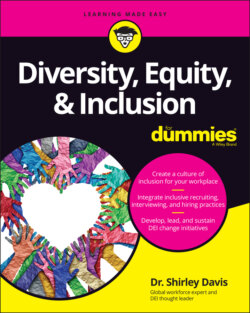Читать книгу Diversity, Equity & Inclusion For Dummies - Dr. Shirley Davis - Страница 17
Equity
ОглавлениеAlthough “equity” and “equality” sound similar, they aren’t the same; consider them related, like cousins but not siblings.
Equity practices cast a very broad net. For example, the U.S.-based Government Alliance on Race and Equity stresses that “equity is about fairness, while equality is about sameness.” In other words, equality is concerned with treating everyone the same, while equity offers the opportunity for assistance so that everyone has a just and fair chance to be successful. Figure 1-2 illustrates this concept.
A democracy assumes that every member of that society has the ability and right to be successful. But the reality of society brings economic, social, and political differences into play along with privilege and exclusion, and these factors can lead to unequal or unattainable access to achieve success. That’s why equity practices are crucial.
Although the terms equity and equality may sound similar, implementing one versus the other can lead to dramatically different outcomes for marginalized or underrepresented people. Here’s how I define them. Equality is defined as each person or group of people being given the same resources or opportunities. On the other hand, equity recognizes that each person has different circumstances and allocates each the exact resources and opportunities they need to reach an equal outcome.
Batshevs/Shutterstock
FIGURE 1-2: Equality versus equity.
In Figure 1-2, you see three people who have unequal access to a system — in this case, the tree that provides fruit. With equal support from evenly distributed resources, their access to the fruit is still unequal. The equitable solution, however, customizes the resources that each person needs to access the fruit, leading to positive outcomes for both people.
The tree appears to be a naturally occurring system, but social systems aren’t naturally inequitable. They’ve been intentionally designed to reward specific demographics for so long that the system’s outcomes may appear unintentional but are actually rooted discriminatory practices and beliefs. In order to restore the historical injustices of society (which I discuss later in the chapter) equity is essential for those marginalized individuals to gain access to opportunities once denied.
Employing equity practices involves bridging gaps between minority and majority groups in organizations. Keep in mind that equity looks different in each organization; however, it occurs when there is a level playing field that enables all talent to enjoy the same opportunities to thrive. Equity practices consider what’s important to a specific workforce. For example, one equity practice may focus on professional development (mentorship programs, scholarships, bonus distribution) and another on providing opportunities for promotion and growth (succession pipelines).
Equity is the process, and equality is the outcome. In other words, equity is essential to achieving true equality.
